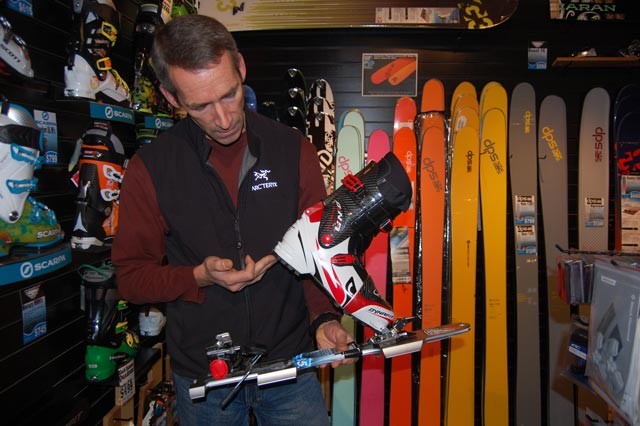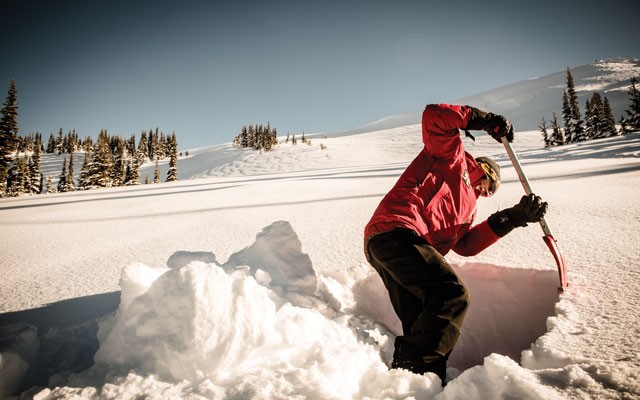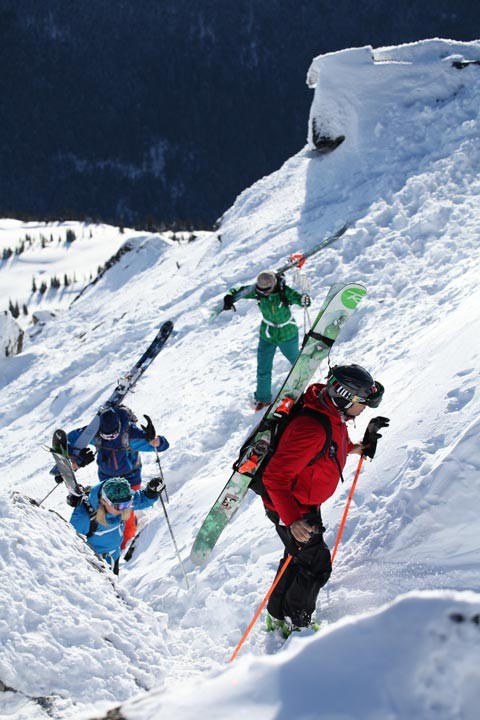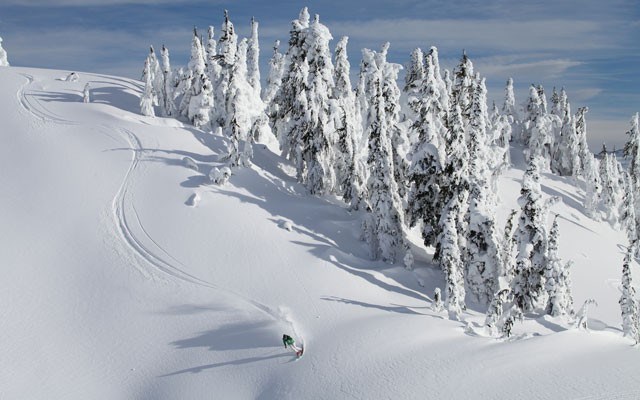Backcountry skiing meant something different in 1990 when Escape Route opened its doors as the first outdoor shop in Whistler.
Back then adventurers hauled their heavy, cumbersome gear out of bounds after acquiring niche safety knowledge and a keen understanding of the terrain. There were no cell phones to call for help or avalanche transceivers to assist with rescues. It was an extreme hobby for the dutifully prepared and determined outdoorsperson.
"It used to be, 'Oh you're a backcountry skier? You cheat death every day!'" says James Retty, co-owner and manager of Escape Route's Whistler and Squamish locations. "Backcountry skiing was a real effort. The clothing was average, with the gear, it was the best we had at the time, but you had to make a choice: 'I'll go ski touring, but I'm going to give up the quality of my downhill ride, so that I can actually hike up (the mountain).'"
Fast-forward two decades. The industry is in a much different place in 2013: backcountry gear has become lighter, warmer and more efficient and retailers are selling more of it every year. The perception of those mountain ranges as a playground for experts has been debunked, in part due to the proliferation of avalanche training courses to teach people how to navigate those areas safely.
Retty estimates his company's backcountry gear sales have spiked at a rate between 12 per cent and 15 per cent, particularly in the last five years. "If you think of 15 years ago, you had a pair of Emory bindings, lots of nylon, lots of plastic, in a plated binding that you put your heavy boot in that had very little range of motion. And when you went to ski down it was soft and floppy," he says. "The boots have increased in their strength, the materials have gotten better. It weighs only 70 per cent of what it did years ago."
In Canada, there are only sales numbers — which many companies guard closely —and anecdotes to document the growth of ski touring. But south of the border, SnowSports Industries America (SIA) keeps close tabs on those numbers and they mirror what locals have observed. Sales of alpine touring boots, for instance, only added up to 5,252 pairs in the 2009/2010 season. Last year that spiked to 77,060. That adds up to sales of over $32.5 million when you combine figures for online, specialty stores and chain shops. Three years earlier, the same figure was just over $2.7 million.
Meanwhile, in its annual Snow Sports Intelligence Report, the SIA found that around 17 per cent of skiers are sticking to ungroomed, in-bound terrain, while seven per cent are venturing into the true backcountry, compared to 73 per cent still skiing resorts. (For snowboarders the numbers are even higher with 20 per cent in ungroomed resort areas and 16.1 per cent in the backcountry.)
In the same report the SIA poses a series of questions: "Will resort backcountry lift participation (a.k.a. ungroomed runs) translate into non-resort backcountry skiing and riding? Is there an opportunity to educate backcountry dabblers? Would increased participation in non-resort backcountry be a good thing?"
Here in Whistler, the answer to all three queries seems to be a resounding yes.
• • •

Since its inception, Whistler Blackcomb (WB) has seen its customers take advantage of easy lift access to its backcountry, but those numbers have soared in recent years. In response to the spike in interest from tourists and locals alike, WB partnered with Extremely Canadian, a company with tenure in the Spearhead Range of Garibaldi Provincial Park (one of the busiest ski touring areas in the country), to offer guided backcountry tours.
"It's always been part of the ski area," says Doug MacFarlane, mountain manager at Whistler Blackcomb. "(Whistler) started with touring. People hiked up the mountains. It's always been part of our culture here. You don't see that in all resorts, but on Whistler and Blackcomb, it's always been part of our experience. More kids are just figuring it out... Hopefully this is where it's going as an industry. It will be good for the resort as a whole. More people are (ski touring) for their vacations. I think that's much more common and it's only growing."
But that new growth is not without challenges. For one, WB has had issues with skiers using backcountry skins to travel up the mountain and access the resort. There are plans underway to implement automatic scanners at lift lines to electronically check for passes. "We currently have random validations going on in areas where folks are known to skin up — areas that are easiest to access the mountain," MacFarlane says. "We'll do sting operations to keep them honest."
Another issue: the idea of a "near country." While the company itself used to use the term to describe the terrain just outside of its in-bound area, they're worried it creates a false sense of security for skiers and riders. Make no mistake, MacFarlane says, once you leave the resort, you're on your own in the backcountry. "If you're leaving the ski area there's no avalanche control, no markings. You need to go back there as prepared as you would at Duffey Lake or way up past Blackcomb. You need to have a plan," he says.
While WB is not responsible to help backcountry adventurers in distress, they're part of a network of companies and agencies that are alerted and spring into action when an incident happens. Often, though, if it's a serious issue like an avalanche, by the time help arrives it's already too late. Anton Horvath, an avalanche forecaster for Whistler Mountain, puts it more bluntly. "A person's best chance for rescue in the backcountry is self-rescue in their own party," he says. "If people are relying on an outside resource to rescue them they're probably going to be dead by the time we get there."
There's actually been a decrease in avalanche deaths in B.C. in recent years (more on that later), but Horvath says they've seen a spike in missing people in the backcountry. "Most of them are heading out, not knowing where they're going and getting lost. They're calling 911 and getting patched through to Whistler Blackcomb and we go find them or Whistler Search and Rescue goes to find them," he says.
For the inexperienced backcountry skier one option is to venture beyond bounds with an expert from Extremely Canadian. Keith Reid, a longtime local, president of the Association of Canadian Mountain Guides and one of the company's guides says his clients run the gamut. "It's really common for people who are reasonably active and have skied a fair bit to want to give it a go," he says. "You get people who haven't skied a lot but are attracted to it. You get people who are really experienced trying to get out as far as they can in a day and returning home, and you get a tremendous number of people now — especially in the Whistler Blackcomb region where you have lightning fast and efficient access — that just want to do one run. The spectrum is really huge."
With growing popularity, there's also been an increased understanding that the backcountry is a complex place that demands respect and carefully gleaned knowledge. "People are aware that you need to be informed or go with a professional," Reid says. "The guide takes on that whole responsibility of the hazard awareness and the usage of the terrain... Even if you have that base level of education, you have to approach that environment very conservatively."
Still, deaths in the backcountry happen every year. Although avalanche fatalities have been on the decline over the last four years, most deaths in B.C. happen in January and February. That has officials concerned about what lies ahead in 2014.
• • •

In late November, the BC Coroners Service, Environment Canada, Parks Canada and the Canadian Avalanche Centre (CAC) held a press conference. Their concern: preventable deaths in the backcountry. On average, 10 people in B.C. are killed every year by avalanches while another 15 die from hypothermia or exposure.
According to the B.C. Coroners Service, half the winter fatalities in the last six years were snowmobilers, most of whom died in avalanches. Around 34 of the total deaths were skiers who largely succumbed to head injuries. Across Canada, the numbers are similar. Between 2000 and 2010 there were a total of 146 avalanche fatalities. Snowmobilers accounted for 41 per cent while backcountry skiers took the second spot with 29 per cent.
But amongst the somber numbers is good news. Last year in B.C. there were just five deaths in the backcountry. Although avalanche experts say that's still five too many, it marks a 30-year low in fatalities in this province.
"This is a really important statistic, considering the increased use of the backcountry," Peter Marshall with the Canadian Avalanche Association, told the press conference. "We've seen increases in the numbers of snowmobilers out there as well as skiers and riders and snowshoers. With this increased use, we've seen a decline in avalanche fatalities. This is largely due to awareness and certification. Last year, about 7,000 people enrolled in a two-day avalanche course and we're seeing a rise again this year."
Talk to any backcountry expert and they'll offer the same advice. If you're going into the backcountry, have a shovel, transceiver and probe (some are also advocates for ABS avalanche airbags that could save your life if you're buried) and get the training to learn how to use them. "Take a two-day avalanche course. You're going to learn how to (assess) avalanche terrain and come up with strategies for travelling through the terrain safely," Marshall said. "You're also going to learn how to perform a rescue. To perform a rescue you need to have essential avalanche safety gear. You need to practice using it... Then, finally, we tell everybody going out in the backcountry to check the avalanche forecast. It will tell you what the hazard is and where you can go safely and the areas you should avoid. People should be checking that on a daily basis."
While there have been fewer fatalities, the less firm statistic is how many incidents occur in which people are successfully rescued. Although the Canadian Avalanche Centre asks people to report these accidents, there's no way to track them. "Near misses are great learning tools, for other people and for the people involved," says James Floyer, senior avalanche forecaster with the CAC. "They indicate local conditions. Someone who goes for a ride and experiences an avalanche has found unstable snow and it's often indicative of unstable snow in that whole area. It forms some of the basis for the warnings we put out."
Floyer further emphasizes the value of proper training with more numbers. Around 80 per cent of people will survive being buried in an avalanche for 10 minutes. Beyond that, the chances start to plummet. When it's been 15 minutes, your odds of emerging alive drop to just 40 per cent. "You can see how important it is to have a very effective rescue device," he says.
• • •

Last March, three people narrowly escaped serious injury in an avalanche on the Spearhead Glacier in the backcountry of Blackcomb Mountain. A snowboarder triggered the Class 2 slide, which travelled about 250 metres and buried a group that was preparing to hike up.
A skier and snowboarder were only partially covered and managed to escape, but the third person was completely buried. Four more skiers and the snowboarder who caused the incident rushed in to help while Blackcomb patrollers were dispatched and jumped into a helicopter with an on-mountain doctor and Whistler Search and Rescue (WSAR). After four minutes of digging, the buried man's friends were able to free him. Unconscious, he came to by the time help arrived. All three were flown to the Whistler Health Care Centre as a precaution.
The frightening incident echoes the message rescuers have long been trying to get out. "Anybody looking outside of their party for avalanche rescue is a fool," says Brad Sills, head of WSAR. "If you see us arriving on scene, things are well progressed at that point."
On average, WSAR — made up entirely of volunteers — gets between 30 and 40 calls from the beginning of the winter season until the end of May. "Without a doubt, backcountry use is growing," Sills says. "It's well documented, not just in Whistler, but throughout the province. The rise in winter responses for people requesting assistance during backcountry recreational activities has risen over 30 per cent in the past 10 years."
Whistler SAR is part of a network of agencies that responds when a distress call comes in. That diverse group includes Whistler Blackcomb (which is not legally obligated to come to the rescue of anyone outside of its bounds) to the RCMP and other for-profit tour companies. They are tied together with pagers and radios and when a call comes in, the group closest to the distressed party will rush out if they're able. "In the old days, groups tended to be more prepared to deal with their own emergencies," Sills says. "Now, the phenomenon is you go out there with your skins and your skis and a little pack and when you get into trouble you call on your cell phone. That might be as simple as a broken binding. Back in the day... we didn't have the luxury of helicopter searching the way we do these days. If you were (waiting for rescue), you were going to perish."
Over his 34 years of service, Sills has seen it all. When he first started, it used to bother him to get called out to preventable incidents, but he's long since learned to let that go. "You understand that's the nature of the business. You're dealing with people that, for whatever reasons, have a diminished capacity for acting appropriately. It's not really for us to pass judgment on the person or, quite often, it's really tragic beyond belief that somebody could do something like this and end up in the situation they're in. Once you've seen that more than a couple of times you start to realize those who get away with it..." he says, trailing off for a moment. "You try to have a frank talk with them about how lucky they are because people you've seen in similar instances aren't breathing anymore."
Last year, snowmobilers in Whistler surpassed skiers for the first time with the most rescue calls. Some of the common incidents were vehicle accidents, blunt force trauma or an injury that prevented them from driving down the mountain. Skiers in the area, meanwhile, most often call when they're lost. "I wish I could say we went out mostly for tourists, but that would be a lie," Sills says. "Typically they're local or Vancouver-based skiers. A lot of people have knowledge of the local area, but they're not exercising proper decision-making. It's a lack of preparation and that's either not checking avalanche forecasts, not planning your route, not knowing your route, not taking the proper equipment and not telling someone what you're doing."
As the new season unfolds, Sills and his WSAR team know without a doubt that they'll be called out to help injured backcountry skiers, riders or snowmobilers this winter. "That's sad because I honestly don't believe it needs to be that way," he says. "I think if people slow down and take it a bit slower and understand the environment, they're not only going to reap more out of it, but they're going to come home for dinner."
But for all the injury and tragedy he's seen in the last three and a half decades, Sills says he fully understands the majestic lure of the backcountry and why more people are venturing out to discover it. "It's the best thing in the world," he says. "The motivation for getting out there is the experience. It's a sensation that you don't get from anything else that you do in your life."
Pick up next week's Pique for our feature story on human factors and the psychology around making decisions in the backcountry.




